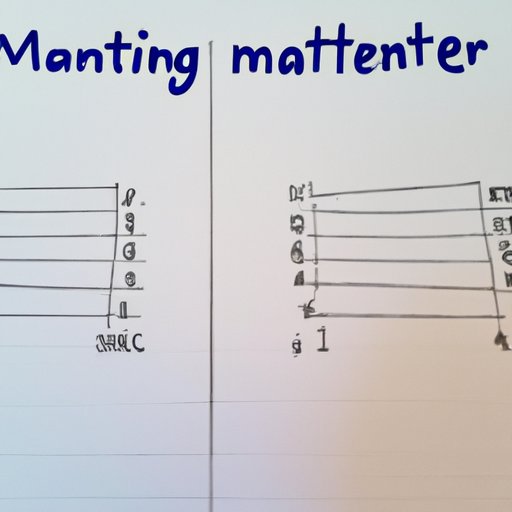
I. Introduction
When it comes to mathematics, multiplication is one of the most fundamental and important operations to master. Long multiplication, in particular, is a crucial skill to possess as it allows us to work with larger numbers and reduces the chances of making errors. In this article, we will explore what long multiplication is, its importance in everyday life, and provide a step-by-step guide on how to do it.
II. A Step-by-Step Guide on How to Do Long Multiplication
Long multiplication can be intimidating at first, but once you break it down into individual steps, it becomes much easier to comprehend. Let’s take a look at the long multiplication process step by step:
Step 1: Write the two numbers you want to multiply on top of each other, making sure the digits are aligned in their respective columns.
Step 2: Multiply the ones column in the bottom number by the top number and write the result below the line.
Step 3: Next, do the same thing with the tens column in the bottom number, but add a zero to the end of the result in order to move it one place to the left. Write this result below the previous one.
Step 4: Keep following this pattern of multiplying each subsequent column in the bottom number and adding a zero to the result before writing it below the previous one.
Step 5: Finally, add up all the results to get your answer.
This might seem like a lot to take in at first, but the more you practice, the easier it becomes. Let’s take a look at an example:
25 x 37 = ?
25 x 37 ----- 175 750 ----- 925
As we can see from the example, once we get the hang of the process, long multiplication becomes much easier.
III. Tips and Tricks for Mastering Long Multiplication
Just like any other skill, mastering long multiplication requires consistent practice. Here are a few strategies and techniques you can use to approach long multiplication problems:
i. Breaking up numbers
Breaking up numbers can make them easier to work with. For example, instead of multiplying 25 x 37, you could break up 37 into 30 and 7, and then multiply 25 by 30 and by 7 separately before adding the two results together.
ii. Estimating
Estimating can also come in handy when working with larger numbers. For instance, if you know that 47 x 38 is roughly equal to 50 x 40, you can use this estimation to arrive at a reasonable answer faster.
iii. Finding patterns to reduce the number of calculations needed
For some problems, you might notice patterns that can help you reduce the number of calculations you’ll need to perform. This is especially true when multiplying by numbers that end in zeros. For example, 57 x 400 is equal to 57 x 4 with two zeros tacked onto the end – easy!
It’s also important to find a way of working that best suits you. Some people prefer to carry out the calculations in their head, while others prefer to write everything down and work through the problem step by step. Ultimately, it’s up to you to find what works best for you and stick with it.
IV. Common Pitfalls to Avoid When Doing Long Multiplication
While long multiplication isn’t necessarily difficult, there are a few common mistakes that people often make. Here are a few pitfalls to watch out for:
i. Lining up digits correctly
One of the most common mistakes people make when doing long multiplication is failing to line up the digits properly. If you don’t align the numbers correctly, you’ll end up with an incorrect answer.
ii. Carrying over correctly
Another pitfall to avoid is carrying over correctly. When you move from one column to the next, you need to make sure you carry any extra digits over to the next column and add them to the result.
iii. Being careful with negative numbers
Finally, when dealing with negative numbers, it’s important to make sure you’re clear on whether you’re multiplying two negative numbers or one negative and one positive number. Get it wrong, and you’ll end up with the wrong answer.
V. Examples of Real-World Applications for Long Multiplication
Long multiplication may seem like a purely academic exercise, but it has real-world applications too. Here are a few examples:
i. Accounting
In accounting, long multiplication is used to calculate revenue and costs, as well as to determine profit margins and perform cost-benefit analyses.
ii. Science
In science, long multiplication is used to calculate the size and mass of celestial bodies, as well as in various calculations related to chemistry and physics.
iii. Engineering
Since engineering involves a lot of calculations, long multiplication is useful in many different areas, including structural engineering and civil engineering.
By mastering long multiplication, you’ll be setting yourself up for success in a wide range of fields.
VI. Practice Problems and Exercises to Reinforce Long Multiplication Skills
The best way to master long multiplication is through consistent practice. Here are some practice problems to work through:
1. 32 x 15 = ? 2. 423 x 17 = ? 3. 56 x 89 = ? 4. 1234 x 567890 = ? 5. 25 x 73 = ?
Once you’ve worked through the problems, check your answers against these:
1. 480 2. 7191 3. 4984 4. 700022660 5. 1825
Make sure to go over the questions you got wrong and try to figure out what went wrong. This will help you identify areas you need to work on and help you become more efficient at long multiplication.
VII. Conclusion
In conclusion, mastering long multiplication is a skill that will serve you well both in and outside of the classroom. By breaking down the process into individual steps and practicing consistently, you’ll find that long multiplication becomes much easier and less intimidating.




